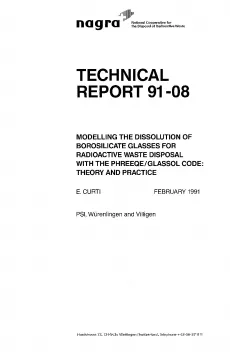
Technical Report NTB 91-08
Modelling the dissolution of borosilicate glasses for radioactive waste disposal with the PREEQUE/GLASSOL Code:Theory and practice
A model describing the corrosion kinetics of silicate glasses has been developed by Grambow in recent years [1,6]. In this report, the theoretical background of the model is thoroughly discussed, and its practical use demonstrated. The main objectives were: (1) to test the validity of the basic assumptions on which the model relies, and (2), to assess whether it can be applied to the safety analysis of a Swiss final repository for high-level radioactive waste.
Transition State Theory, a tool based on quantum mechanical principles, has been used by Grambow to derive a general kinetic equation for the corrosion of silicate glasses. This equation predicts successfully the observed dependence of the corrosion rate on the silicic acid concentration in solution according to a first order kinetics law. However, some parameters required by this equation are determined on the base of questionable assumptions. In particular, the simplistic surface complexation model used for the calculation of the free energy of the glass-water reaction yields, for the protonation of silicon on the glass surface, results which are not consistent with the experimental findings [10]. Further, although the model predicts a unique value, common to all silicate glasses, for the activation energy of the rate-determining elementary reaction, leaching experiments conducted on a wide variety of glasses suggest that this quantity may vary by a factor 2.
In its present form, the model is judged to be unsuitable for the safety analysis of the Swiss final repository. The reasons include: (1) the model neglects the potential effects of diffusive transport and silica sorption in a bentonite backfill on the glass corrosion kinetics; (2) the release of radionuclides can be only modelled assuming congruent dissolution; and (3), the magnitude of the final rates of corrosion, the parameter defining the maximal lifetime of the glass matrix, is still not known with sufficient precision.
